| Retrotracks |
JPK 90 Belgian version |
|||
Kit : # 72067 |
Review
by Marc Mercier |
|||
| Retrotracks |
JPK 90 Belgian version |
|||
Kit : # 72067 |
Review
by Marc Mercier |
|||
What do you get? Being the last descendant of the long family line of World War 2 Jagdpanzers, the JPK is well known for his service with the Bundeswehr during the Cold War. However, few people are aware of the fact that between 1975 and 1992, the Belgian army also used 80 vehicles. Retrotracks offers a resin kit of the Belgian version, which differs slightly from the German one. The most obvious differences are the tracks, roadwheels and suspension (which are those of the German Marder APC), the absence of a light projector (and its attachments) on the mantlet (Belgium preferred the use of two Swedish Bofors 71mm Lyran flare launchers for illuminating targets at night) and a Belgian FN MAG machinegun on the loaders hatch instead of the German MG3. |
||
Now for a closer look... As customary
with Retrotracks, all the parts are safely stored inside a sturdy
cardboard box. There is a small amount of flash on the smaller parts and some air bubbles can be seen. However, nothing dramatic. The level of detail in general is very sharp. Below some enlarged images as examples: a headlight and the spare track holder.. |
||
| Cutting resin parts from the pouring block and cleaning them up can sometimes a bit of a challenge, certainly when those parts are small and/or fragile. From a modeller's point of view, this means: the less contact with the pouring block, the better. However, from a manufactures point of view, more contact with the pouring block is better, because easier to cast with a higher success rate (meaning more profit) and less breakage during handling and transport. Therefore the mould maker often has to compromise. | ||
From my past experiences, Retrotracks always has paid particular attention to this aspect. Just look at the back of this mirror: instead of casting that part completely to the block, you get a small opening where you put a knife in (Yellow). Superb! Same story with the Lyran tubes (red oval), contact with the pouring block is minimal, but still strong enough to get a perfect straight tube, which is secured during transport and handling. |
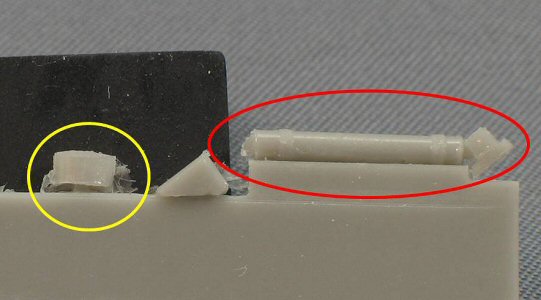 |
|
The designer has opted to cast the hull upside down, which means the remaining pouring block is on the back of the hull. I like this original approach, because it means less cleaning and cutting. The belly is a gaping hole, which shouldn't be a problem. |
||
In
general, you get a very nice representation of the real thing with
lots of detail already cast on the hull.
|
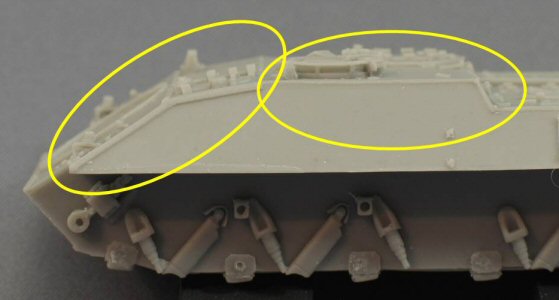 |
|
| The
gun mantlet is nicely reproduced and has a nice cloth cover in resin.
However, this means the gun (which, in real life, can move in both horizontal
and vertical plane) can only be glued in one position. Should you wish to alter this position, be ready for some cutting and filling work. |
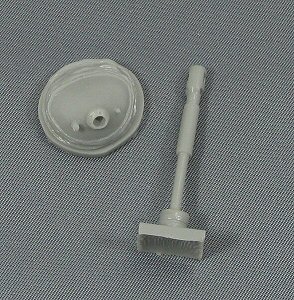 |
|
The Lyran flare launchers, next to the vehicle commander's hatch, can only be assembled in a raised 45° position, which is the usual situation during night combat. When not in use (e.g. in daytime or during long movements) they were stowed horizontally in their travel lock, pointing to the rear. Retrotracks has moulded a nice reproduction of this travel lock directly on the engine deck. Since these mortars were considered as being a weapon, they could easily be removed for safe storage in the armoury. So, when not needed (e.g. during maintenance or in the parking area) they were mostly left off. Additionally, during gunnery training, sometimes a lazy crew installed only one launcher to decrease the maintenance workload afterwards. |
||
| The alignment of the two sets of four smoke grenade launchers does not look quite right. Compare the resin parts with the real stuff on the right | ||
The tracks (link and length) and roadwheels are slightly adapted copies of the Revell Marder APC; see green parts on the assembly sheet below. They are nicely reproduced, but some air bubbles can be seen. The torsion arms are provided as separate parts, which means you can play with the suspension systems to adapt itself to the terrain. But beware, the shock dampers then also need to be adjusted... |
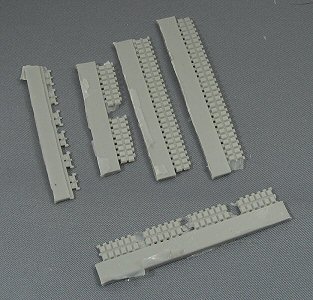 |
|
| Tools and other small stuff are moulded separate from the hull, something I like very much. However, one important item is absent in the kit, the superstructure FN MAG and its cradle, normally seen on the loaders position. | 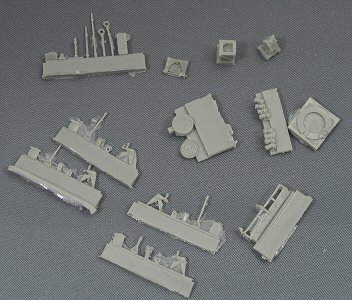 |
|
The
two pages instruction sheet, although kept simple, overall should
do the job. It has numerous clear pictures with connecting lines where
everything should go. Nevertheless, having some clear images of real
vehicles in action could be helpful. |
||
Decals and markings None are provided in this kit, which I always find a pity.------------------- |
||
| Conclusion This is a nice reproduction of rare vehicle and should be warmly welcomed by enthusiast of Cold War vehicles. I'm sure the layout and design of the kit will make this one a pleasure to build. Preview sample purchased by the author. Note : the moulds for this kit have been sold to Tas Models, who offer it as kit # TM057. |
||
Back to Retrotracks Kit List |
Back to Home Page |
Article Last Updated: 13 May 2018 |